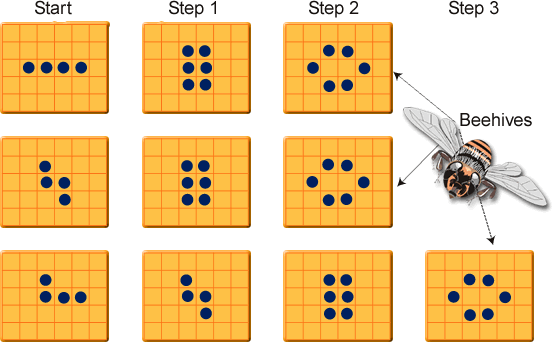![]()
The best-known example of a cellular automaton is the “Game of Life”, devised by the British mathematician John Conway in 1970. The game is very simple. It consists of a two-dimensional grid of cells and each cell is in one of two states: “alive” (ON) or “dead” (OFF). Initially we randomly select a group of cells and bring them to life; i.e. set their state to “alive” by placing a blue marker on each such cell. The remaining cells are all “dead”. We now begin to play the game. Each cell has eight neighbours, and these neighbours, together with the following rules are used to simultaneously update the state of each cell.
| Rules: | ||
| 1. | A dead cell with exactly 3 live neighbours comes alive (or is “born”). | |
| 2. | A live cell with 2 or 3 live neighbours stays alive; otherwise it dies (either from “loneliness” or “overcrowding”). | |
This process is repeated and grids evolve presenting many beautiful and fascinating patterns.

Game of Life enthusiasts have named many of these patterns: blocks, beehives (shown above), boats, ships and loaves are all “stable shapes”, blinkers and toads are “oscillators and gliders”, Queen Bee Shuttles are moving objects which can cause havoc. There are even other more complicated objects such as “the glider gun”. (Search the www for “Mirek Wojtowicz”. You may download Mirek’s Cellular Automata Explorer and you will soon learn to simulate the Game of Life and many other cellular automata).
It is even possible to construct logic gates AND, OR and NOT using these moving objects, giving the Game of Life the same computational power as a computer [Universal Turing Machine].
